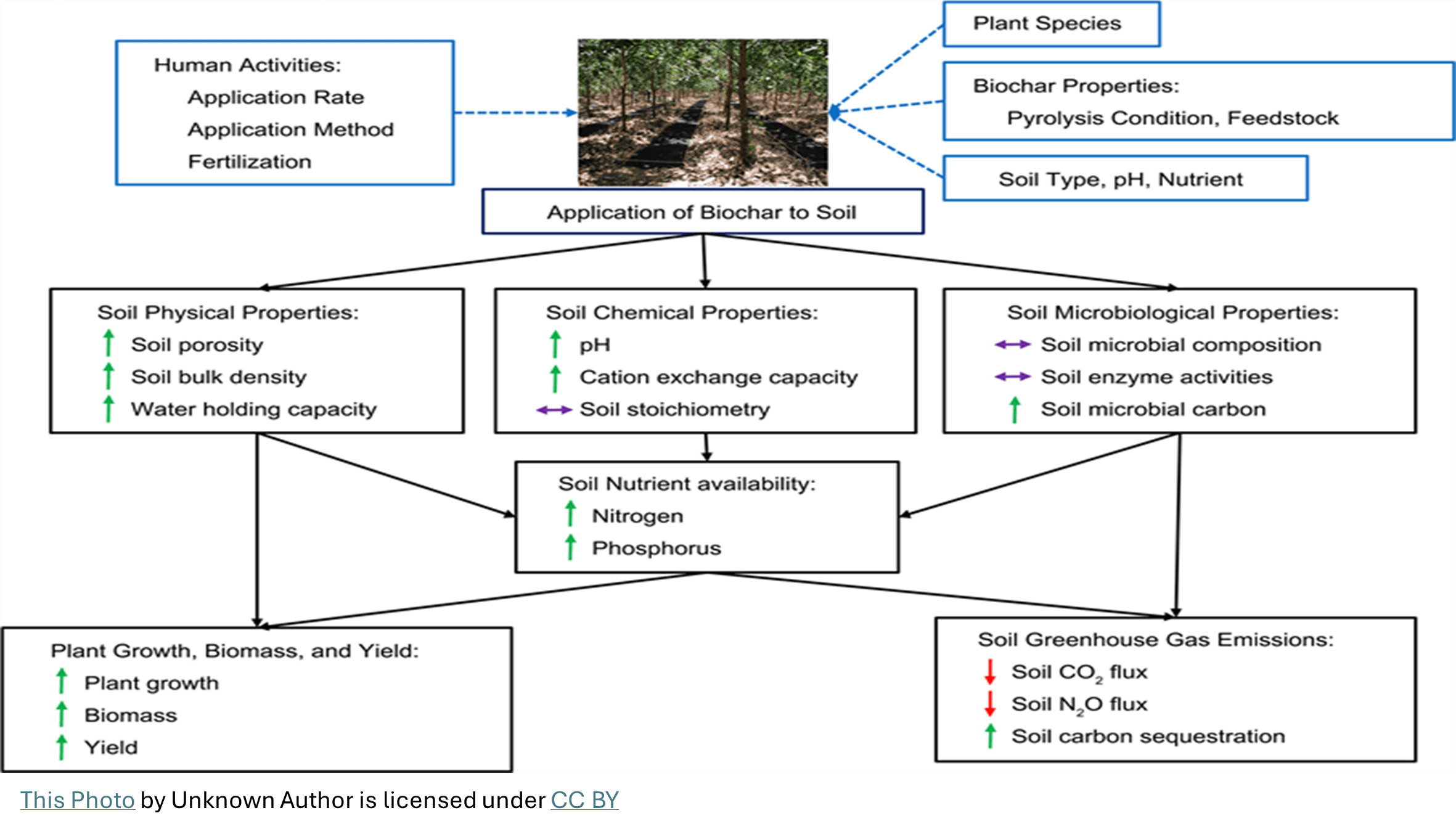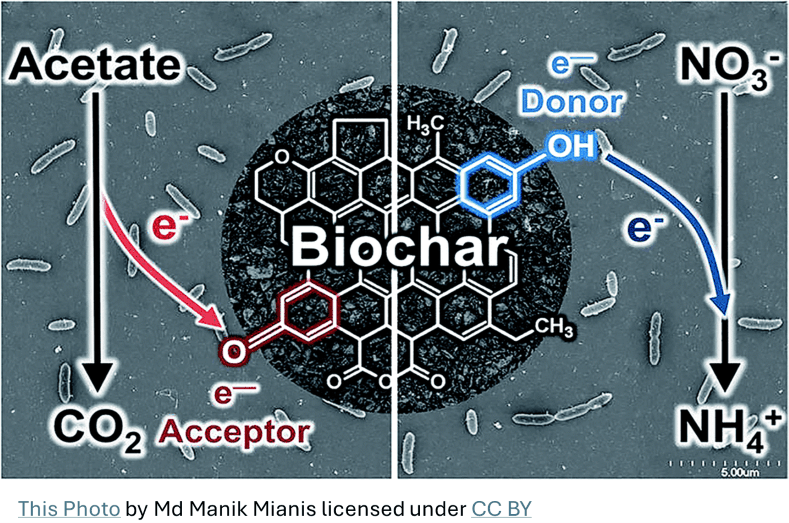Biochar: What is it, How Does it Work, and What is it Worth?
Biochar has been gaining interest among farmers, particularly those with sandy soils. But what exactly is biochar? How does it impact soil health, and is it a worthwhile investment? Let’s delve into these questions.
What is Biochar?
Biochar refers to organic matter, often derived from agricultural or lumber byproducts, that undergoes a process called pyrolysis. During pyrolysis, the substance is heated in an oxygen-free or low-oxygen environment, resulting in the production of three main components: gases, bio-oil, and biochar. The specific ratio of these outputs can vary based on factors such as temperature and duration of the process. Unlike traditional combustion, pyrolysis yields biochar instead of ash, making it a distinct and valuable method for transforming organic materials.

Benefits of Biochar
Water Retention
One of the primary benefits of biochar is its ability to retain water. This is particularly beneficial in sandy soils, which typically have poor water retention. By adding biochar, farmers can improve the water-holding capacity of their soils, reducing the need for frequent watering and potentially saving on irrigation costs. This is possible due to the extremely porous nature of biochar, providing plenty of pockets for water to be stored.
Microbial Apartment Complex
The biochar’s structure provides a habitat for soil microbes. With a surface area of roughly 2,500 square meters in just 1 gram of biochar, there’s plenty of room for beneficial bacteria and fungi to thrive. Furthermore, the many binding sites of biochar allows it to hold on to various molecules this means biochar is able to provide water, shelter, and a full buffet to all the microbes that call it home. These microbes play a crucial role in nutrient cycling and can enhance soil fertility. In the picture below we can see all the nooks and crannies in every microscopic piece of biochar, these nooks are sites that make great microbial homes. These sites for microbes allow for the establishment of larger microbial communities enhancing your soil’s nutrient cycling potential. Which will allow your fertilizer to be even more effective.
Nutrient Retention
Biochar isn’t just a great home for microbes and water, those porous cavities are also perfect for storing nutrients and preventing run-off. Fertilizer run-off can not only be devastating to the local environment, but also on the pocketbook. Every gram of fertilizer applied that is washed away is a waste of money for the farmer and biochar can help to reduce that waste. Some studies have even shown a 26% increase in yield when using biochar combined with fertilizer when compared to fertilizer alone. (Ye, 2020)
CO2 Sequestration
One of the less discussed benefits of biochar is its ability to sequester carbon. If the organic waste produced on a farm was sent to a landfill or just piled up to rot somewhere, the organic matter buried in that pile will eventually break down releasing methane into the atmosphere, a gas with 70 times the heat trapping potential of CO2. By subjecting this material to pyrolysis, we can stop methane from being produced and instead store that organic matter’s carbon in the soil. It should also be mentioned that between 1.9-2.7 tons of CO2 is sequestered per every ton of biochar produced, biochar CO2 Removal credits or the CORC Biochar Price Index CORCCHAR which is owned by NASDAQ is at $169.92 USD/Ton. (CORC Carbon Removal Price Indexes, n.d.)
Risks of Biochar
Nitrogen Immobilization

Another risk associated with biochar is nitrogen immobilization. When biochar is first added to soil, it can absorb some of the nitrogen, making it unavailable to plants. However, this effect is typically temporary and can be mitigated by pre-charging the biochar with nitrogen or by applying biochar mixed with compost or fertilizer. On a molecular level biochar has plenty of binding sites with most of these sites being positively charged; and with nitrate or NO3- being negatively charged it is able to easily bind with sites on the biochar. As many farmers know NO3 is the most commonly applied form of nitrogen, which makes this interaction very important to note.
Long Lasting
As biochar can persist in soil for decades, centuries, even millenia, it becomes crucial to thoroughly evaluate whether incorporating biochar is the optimal choice for your soil. Remember, once biochar is introduced, it becomes a permanent fixture, shaping the soil ecosystem for generations to come. Research has shown a correlation between the half-life of biochar and its O/C molecular ratio. When the O/C molecular ratio of biochar is less than 0.2, the half-life is anticipated to exceed 1000 years. If the O/C molecular ratio falls between 0.2 and 0.6, the half-life is likely to be within the range of 100 to 1000 years. However, if the O/C molecular ratio is greater than 0.6, the half-life could be less than 100 years. (Elmquist, 2006)
Mixed Results
A review of 44 studies on biochar showed no increase in yield with biochar application for about 50% of studies reviewed. (Ippolito, 2012) Studies have shown that the most benefits yielded from biochar in are sandy or degraded soils. Additionally not all biochar is created equally, people use everything from manure to lumber to generate biochar and they can vary greatly, while the choice of feedstock has the largest effect on the form of the biochar and the organic volatiles that help to form those charged binding site; Temperature and time play huge roles in determining the composition of your biochar. Fast pyrolysis typically has higher surface area, S, P, K, Ca, and MG but produces less biochar overall and will typically have a higher pH and produce more ash. (Tu, P., Zhang, G., Wei, G. et al. 2022)
Cost of Biochar
The cost of biochar can vary widely depending on the source material and the method of production. While it can be a significant upfront investment, the long-term benefits in terms of improved soil health and productivity can make it a worthwhile expense for many farmers.
Commercially available wood biochar ranges from about $300-$400 a ton. With recommended rates between 1-10 tons per acre (Schmidt et al. 2021) these costs can quickly add up for farmers. It is important to note that due to the longevity of biochar this quantity of application should be once in a farm’s lifetime. Biochar could also be added in small amounts gradually building up and changing the soil.
Biochar Application Rates
Biochar’s benefits can be seen across the spectrum, but those benefits can vary greatly depending on the amount of biochar being applied at 1 ton per acre it is typical to see improvements in the soil microbiome, at applications of 3 tons per acre or greater we will start to see boosts in the soils OM ranging from .15 to .35%. Some studies even saw beneficial results at up to 10 tons per acre.
Biochar or Compost?
When managing your waste streams there are a lot of decisions to be made, and as biochar has immense longevity in the soil it won’t need to be reapplied very often - so don’t go build your home pyrolysis systems just yet. Unless you’re utilizing the power from pyrolysis and have a place to offload any extra biochar, maybe consider composting to utilize your waste stream in a way that can be reapplied year after year and help to boost your soil’s OM. A properly maintained compost is well aerated which prevents the anerobic reaction that produces methane that pesky greenhouse gas. Compost also can provide essential nutrients back to your soil in a plant available form.
Alternatively, the best option maybe a mixture of both management systems, biochar added between 5-20% by volume into compost can be a great addition, take away some of that risk of nitrogen immobilization, and provide most of the great benefits we’re already familiar with from biochar.
Conclusion
While biochar can significantly enhance the water retention capacity of soils that are deficient in this aspect, it may pose a risk of nitrogen immobilization in soils that are already healthy. Therefore, biochar is not a universal solution for all soil types. Additionally, with biochar’s longevity in soil, the cost benefits from continued or larger frequent additions of biochar diminish as your soil health improves. However, in the appropriate agricultural context, it can bring about substantial improvements. If you believe that biochar could be a suitable solution for your farming needs, or if you’re interested in learning more about composting, Terraforma is always available to provide further information and guidance.
Sources:
Ippolito , J. (2012, July). (PDF) environmental benefits of biochar. Enviromental benefits of Biochar. https://www.researchgate.net/publication/228102856_Environmental_Benefits_of_Biochar
Schmidt, H.-P., Kammann, C., Hagemann, N., Leifeld, J., Bucheli, T. D., Sánchez Monedero, M. A., & Cayuela, M. L. (2021). Biochar in agriculture – A systematic review of 26 global meta-analyses. GCB Bioenergy, 13, 1708–1730. https://doi.org/10.1111/gcbb.12889
Lehmann, J., & Joseph, S. (Eds.). (2015). Biochar for Environmental Management: Science, Technology and Implementation (2nd ed.). Routledge. https://doi.org/10.4324/9780203762264
Ye L, Camps-Arbestain M, Shen Q, Lehmann J, Singh B, Sabir M. Biochar effects on crop yields with and without fertilizer: A meta-analysis of field studies using separate controls. Soil Use Manage. 2020; 36: 2–18. https://doi.org/10.1111/sum.12546;
Elmquist, M., G. Cornelissen, Z. Kukulska, and Ö. Gustafsson (2006), Distinct oxidative stabilities of char versus soot black carbon: Implications for quantification and environmental recalcitrance, Global Biogeochem. Cycles, 20, GB2009, doi:10.1029/2005GB002629
Hui, D.F. (2021) ,Effects of Biochar Application on Soil Properties, Plant Biomass Production, and Soil Greenhouse Gas Emissions: A Mini-Review. Agricultural Sciences, 12, 213-236. https://doi.org/10.4236/as.2021.123014
Tu, P., Zhang, G., Wei, G. et al. Influence of pyrolysis temperature on the physicochemical properties of biochars obtained from herbaceous and woody plants. Bioresour. Bioprocess. 9, 131 (2022). https://doi.org/10.1186/s40643-022-00618-z
CORC Carbon Removal Price Indexes. (n.d.). Puro.earth Oy. Retrieved April 26, 2024, from https://puro.earth/corc-carbon-removal-indexes
start your soil journey today
contact us